IMPACT OF THE PANDEMIC ON TRADE, TOURISM AND GENERAL DEVELOPMENT IN AFRICA
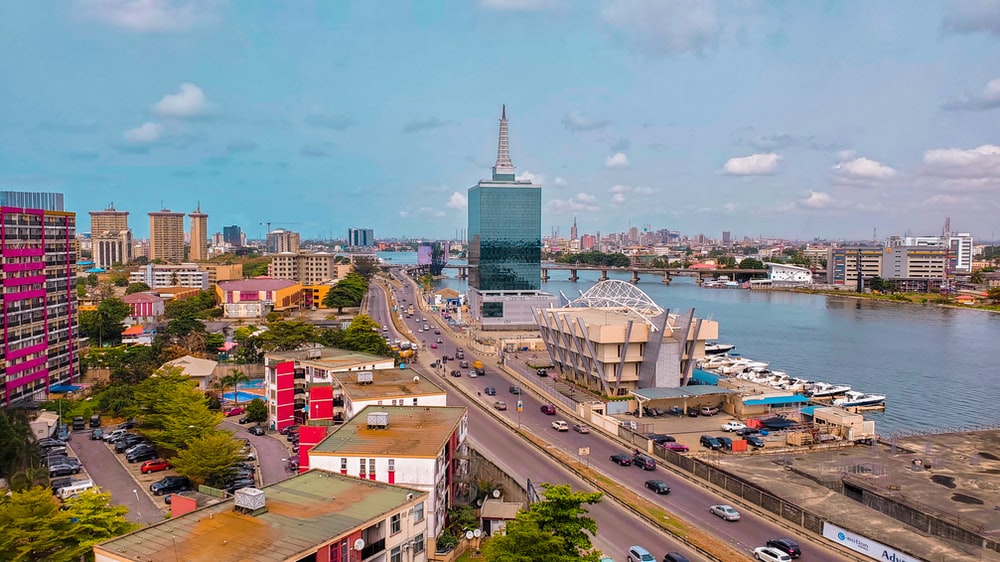
Kalo Africa Media
By chinyelu

Nigeria
According to the National Bureau of Statistics (NBS), Nigeria’s inflation increased to 15.63% year-on-year in December 2021 from 15.40% year-on-year in November 2021, after 8 months of consecutive decline since April 2021. Food inflation climbed to 17.37% year-on-year in December 2021, representing a 16 basis points (bps) increase from the rate of 17.21% recorded in November 2021 and Core inflation increased by 2 basis points (bps) from 13.85% in November 2021 to 13.87% in December 2021. The increase in inflation can be largely associated with the year-end holiday season.
The Central Bank of Nigeria (CBN) maintained status quo on all monetary policy parameters at its first monetary policy committee meeting in 2022, as widely expected. However, the committee raised concerns about the fact that the Nigerian National Petroleum Corporation (NNPC) emittances have declined. This was largely attributed to oil theft and underscores the fact that subsidy is a drag on government revenue.
In a presentation of the approved 2022 budget, the Minister of Finance, Budget and National Planning, Mrs. Zainab Ahmed, revealed that Nigeria’s debt stock had risen by 20.4% in 11 months from ₦32.9 trillion in December 2020 to ₦39.6 trillion in November 2021. Mrs. Zainab Ahmed, also revealed that the Federal Government has suspended the removal of the planned fuel subsidy till further notice.
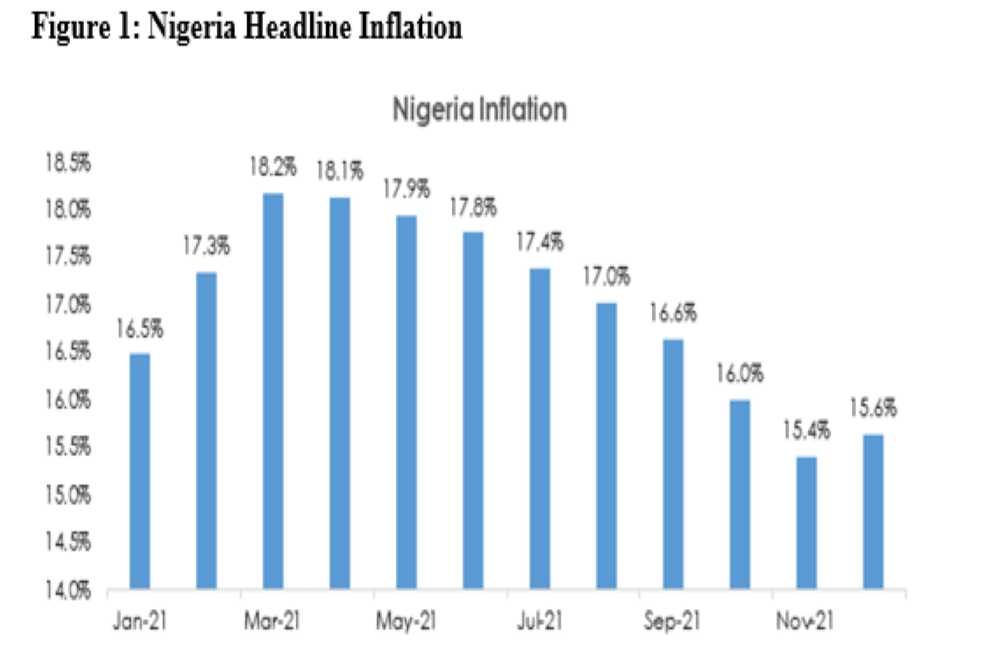
Ghana
Ghana’s producer prices increased by 12.8% year-on-year in December 2021, despite a decrease of 0.2% month-on-month, according to the Ghana Statistical Service.
According to a statement by the Bank of Ghana (BoG), Ghanaian banks can now accept offshore debt securities (sovereign, corporate and multilateral) as collateral for loans. The securities, however, must be dollar, pound, euro or yen-denominated and rated AA and above.
The international rating agency, Fitch, downgraded Ghana’s long-term foreign-currency Issuer Default Rating (IDR) to “B-“, over rising concerns about the sovereign’s ability to service its debts in the medium to long-term. This implies the government would have to rely on domestic borrowings. While the maturity of the foreign bond holdings is long-term, an outflow would put additional downward pressure on Ghana’s reserves.
The World Bank’s Global Economic Prospects reports that the Ghanaian economy is forecasted to expand by a 5.5% margin in 2022.
Senegal
Consumer prices in Senegal rose 3.8% year-on-year in December 2021, compared to 3.0% in November 2021, according to the National Agency of Statistics and Demography of Senegal (ANSD).
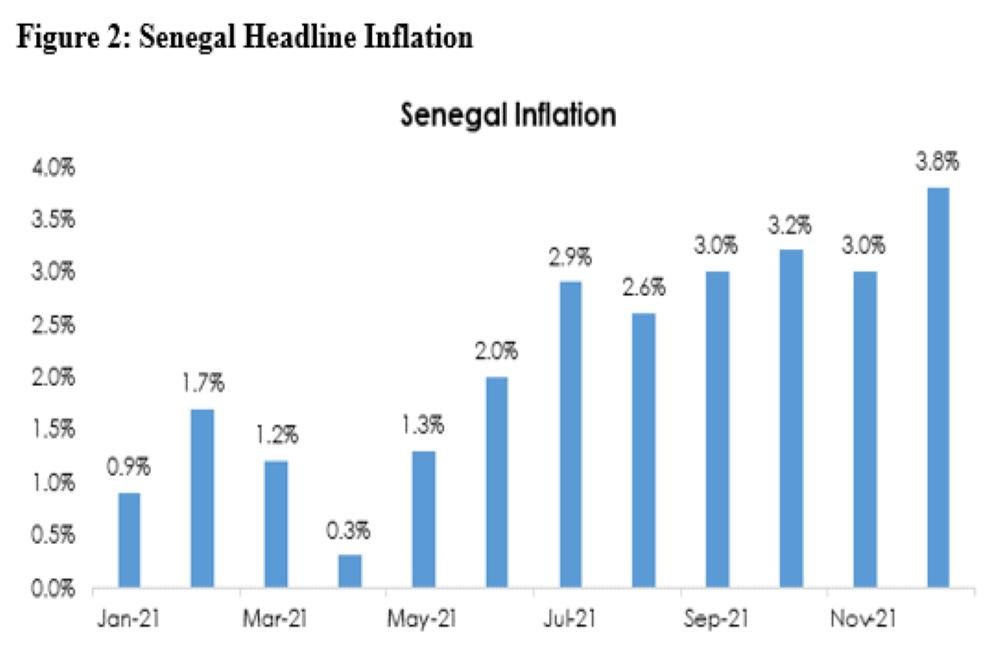
The International Monetary Fund (IMF) approved Senegal’s three-year Policy Coordination Instrument (PCI) which is supposed to be built around achieving inclusive and private-sector-led growth, consolidating macroeconomic stability, as well as managing oil and gas revenues in a sustainable and transparent manner.
Ivory Coast
According to Ivory Coast’s statistical bureau, headline inflation printed at 5.6% year-on-year in December 2021, with an average of 4.2% in the fiscal year 2021.
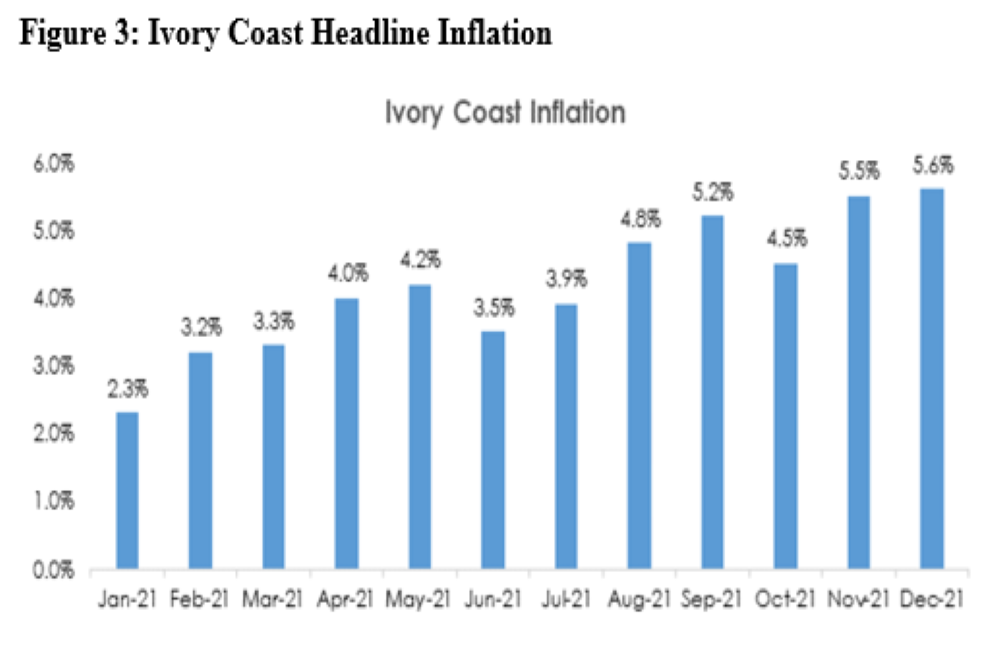
Ivory Coast recorded a total of 99,024 tonnes of cocoa exports between 3rd – 9th January 2022. The total export since 1st October 2021 fell to 1.2 million tonnes in comparison to 1.3 million tonnes in 2020.
Kenya
Transactions made by mobile money agents in Kenya increased 36.0% month-on-month in November 2021, and 34.8% year-on-year from Sh4.6 trillion recorded in November 2020, according to the nine months to November 2021 data from the Central Bank of Kenya (CBK).
The central bank had introduced reliefs on mobile phone payments in March 2020 which allowed free mobile money transactions of up to Sh1,000 from banks to mobile wallets, to encourage cashless payments.
Data from the Tourism Research Institute showed an increase in international tourist arrivals, as Kenya received 870,465 tourists, 53.0% higher than 567,848 in 2020. USA was the major tourist source for Kenya with 136,981 followed by Uganda with 80,067 and Tanzania with 74,051 tourists.
The Ministry of Tourism and Wildlife forecasts an 18% year-on-year increase in tourism earnings from 146.5 billion to 172.9 billion in 2022.
Tanzania
Tanzania’s current account deficit widened to c.$346.0 million in November 2021 from c.$166.0 million in October 2021. The year-to-Nov-2021 deficit prints at $2.0 billion, compared to $841.0 million in November 2020. This is attributable to a reversal in the pandemic-induced effect on terms of trade.
According to the Bank of Tanzania (BoT), public debt stood at $36.1 billion by the end of November 2021, $5.3 billion higher than November 2021, with external debt adding $4.1billion to print at $28.0 billion and debt service payments in November 2021 amounted to $171.4 million.
According to the National Bureau of Statistics, Tanzania’s annual headline inflation rate for December 2021 printed at 4.2%, up by 100 basis points (bps) year-on-year compared to 3.2% recorded in the same period in 2020. On a monthly basis, inflation rates rose up 0.8% in December 2021, after a 0.5% increase in the prior November 2021.
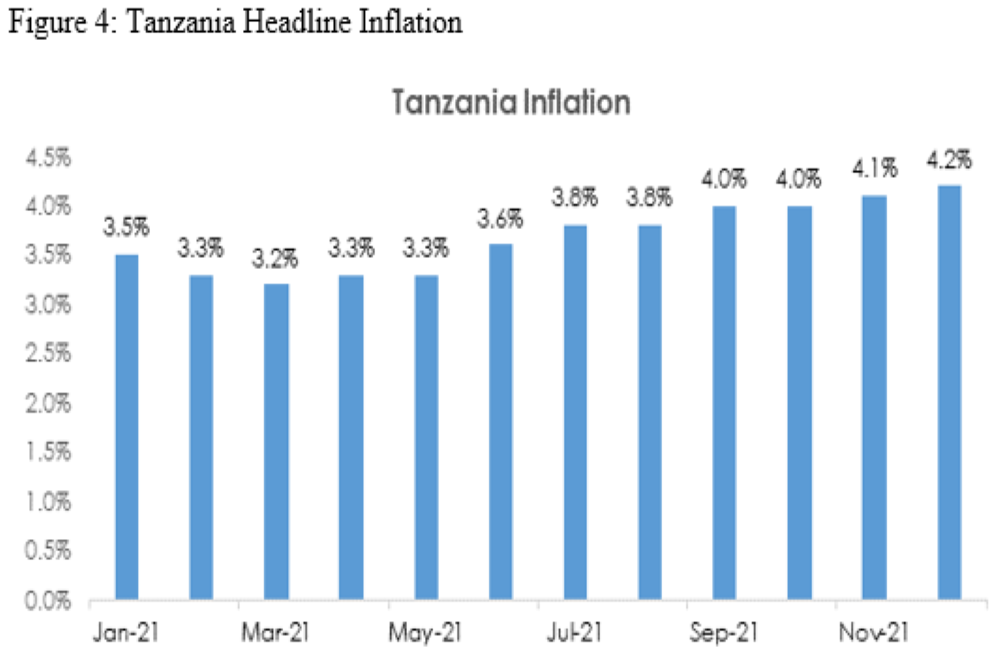
Zambia
According to the Zambian Reserve Bank, money supply M3 growth accelerated to 9.4% in October 2021 compared to 8.9% in the previous year. On a monthly basis, supply rose by 1.8%.
The Central Bank of Zambia recorded a reduction in gross reserves from $2.6 billion in October 2021 compared to $2.9 in September 2021.
Zambia’s finance minister, Situmbeko Musokotwane said on Friday he expected the country to reach full agreement with the International Monetary Fund (IMF) in the middle of this year, after reaching a staff-level agreement for a $1.4 billion support plan in December.
Chad
The International Monetary Fund (IMF) said on Tuesday that public and private creditors need to finalize a debt restructuring plan with Chad by the end of March to restore durable growth amid worsening conditions in the African country. Chad’s real GDP in 2021 is estimated to have contracted by 1.1%, driven by a reduction in oil production, while average annual inflation was contained after soaring in 2020 to 4.5%.
Source: UBA







